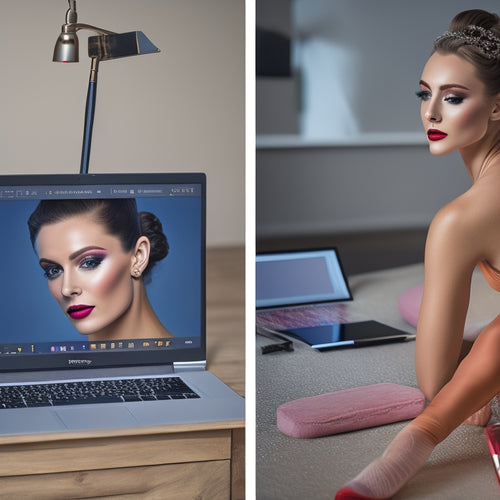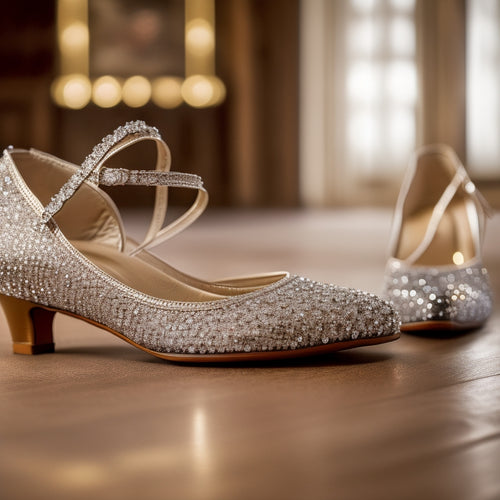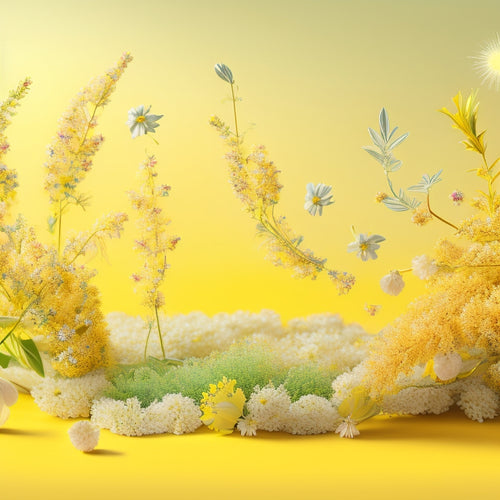
Why Backdrops Make or Break Belly Dance Photos
Share
When capturing belly dance photos, a well-designed backdrop can make all the difference. You'll want to balance contrasting elements, incorporate textures and patterns, and choose materials that evoke a specific mood. Colors, too, play an essential role in setting the tone, with warm tones evoking passion and cool tones conveying serenity. By mixing and matching fabrics, adding props, and layering elements, you'll create a visually stunning atmosphere. But that's just the beginning - the perfect backdrop can transport your audience to a world of beauty and mystery, and there's still so much more to explore.
Key Takeaways
• A well-designed backdrop can elevate the mood and atmosphere of the photo, transporting the viewer to a specific time and place.
• A cohesive backdrop design guides the viewer's eye to the dancer, ensuring they remain the focal point of the image.
• The right textures and patterns on the backdrop can add depth and visual interest, complementing the dancer's attire and props.
• A backdrop that clashes with the dancer's costume or props can distract from the overall aesthetic, breaking the illusion of the image.
• By incorporating props and cultural symbols, the backdrop can help weave a narrative, adding depth and meaning to the photograph.
Essential Elements of Backdrop Design
When designing a backdrop for belly dance photography, you'll want to incorporate essential elements that create a cohesive and visually appealing atmosphere, drawing the viewer's attention to the dancer. A well-crafted backdrop is vital in creating a stunning image that showcases the dancer's movements and expression.
To achieve this, you'll need to guarantee contrast balance in your design. This means striking a balance between light and dark areas, as well as incorporating a mix of textures and patterns to create visual interest. A backdrop that's too uniform can result in a dull, flat image. Instead, aim for a balance of contrasting elements that guide the viewer's eye to the dancer.
Material selection is also critical in backdrop design. You'll want to choose materials that are durable, easy to set up, and can withstand the demands of a photo shoot. Consider using materials with interesting textures, such as velvet, lace, or silk, to add depth and visual interest to your backdrop.
Setting the Mood With Colors
You can evoke a specific emotional response from the viewer by carefully selecting colors that align with the mood and atmosphere you want to convey in your belly dance photography.
Colors have the power to transport the viewer to a specific time and place, and when used intentionally, can elevate your photography to the next level.
To guarantee color harmony, create a mood board to visualize your color palette before the shoot. This will help you identify potential clashes and make adjustments accordingly.
Consider the emotions and moods you want to evoke: warm colors like orange and red can create a sense of energy and passion, while cool colors like blue and green can evoke feelings of calmness and serenity.
Textures and Patterns Matter
Every belly dance photography set benefits from incorporating a mix of textures and patterns to add depth, visual interest, and authenticity to your images. You can achieve this by incorporating a variety of fabrics, from smooth velvets to intricate lace, and mixing them with patterns that complement or contrast with each other.
Here are some tips to keep in mind:
-
Mix and match fabrics: Combine smooth fabrics like silk or cotton with textured fabrics like lace, tulle, or crochet to add depth to your images.
-
Balance patterns: Avoid pattern overload by balancing bold patterns with simpler ones, and mixing large patterns with smaller ones.
-
Play with scales: Experiment with different scales of patterns, from small florals to large geometrics, to add visual interest.
-
Consider the dancer's attire: Make sure the dancer's costume complements or contrasts with the backdrop's textures and patterns to create a cohesive look.
-
Don't forget about the floor: Incorporate textured or patterned flooring to add an extra layer of depth to your images.
Using Props to Enhance Story
Incorporating thoughtful props into your belly dance photography setup helps weave a narrative around the dancer, adding an extra layer of emotional resonance to your images. You can use cultural symbols, such as intricately decorated fans, ornate veils, or traditional Middle Eastern instruments, to add depth and meaning to your photos. Whimsical touches, like flowers, feathers, or shimmering fabrics, can also be used to evoke a sense of playfulness and freedom.
| Prop Idea | Cultural Significance | Whimsical Touch |
|---|---|---|
| Decorated Fans | Symbol of elegance and sophistication in Middle Eastern culture | Adds a touch of glamour to the photo |
| Ornate Veils | Represent modesty and mystery in belly dance tradition | Adds a sense of allure and mystery to the image |
| Traditional Instruments | Represent the rich cultural heritage of the Middle East | Adds a sense of authenticity to the photo |
| Flowers or Feathers | Symbolize femininity and playfulness | Adds a touch of whimsy and lightness to the image |
Creating Depth With Layering
By thoughtfully layering elements in your belly dance photography setup, you can create a sense of depth that draws the viewer's eye to the dancer. This technique not only adds visual interest but also helps to establish an atmospheric focus that immerses the viewer in the scene.
To achieve this, consider the following layering strategies:
- Use a textured backdrop to add depth and visual interest
- Incorporate props or set dressing that complement the dancer's costume and theme
- Experiment with layering fabrics, veils, or other transparent elements to create a sense of depth and mystery
- Position the dancer at an angle or use a shallow depth of field to create a sense of visual hierarchy
- Balance warm and cool tones to create contrast and visual interest
Frequently Asked Questions
Can I Use a Plain Colored Wall as a Backdrop for Belly Dance Photos?
"Hark, brave dancer! You ask if a plain colored wall can be a worthy backdrop? Absolutely! A smooth wall texture and harmonious color palette can elevate your belly dance photos, so go for it, and shine!"
How Do I Avoid Distracting Shadows on My Backdrop During a Photoshoot?
To avoid distracting shadows on your backdrop, you'll want to master softbox lights and shadow mapping techniques to soften and redirect harsh light, creating a flawless, distraction-free background that makes your belly dance photos shine.
Are There Any Specific Backdrop Materials Suitable for Outdoor Belly Dance Photoshoots?
When choosing backdrops for outdoor belly dance photoshoots, you'll want water-resistant fabric or outdoor textiles that can withstand the elements. Look for durable, weather-friendly materials that won't fade or rip easily, ensuring your photos shine.
Can I Create My Own Custom Backdrop for a Belly Dance Photoshoot?
You can create your own custom backdrop for a belly dance photoshoot, leveraging DIY fabric options to harness creative freedom, allowing you to tailor the aesthetic to your unique style and vision.
How Do I Store and Transport My Backdrops Safely During Travel?
Did you know 75% of photographers damage their gear during travel? You won't be one of them! When storing and transporting your backdrops, invest in sturdy Rolling Cases and Weatherproof Bags to guarantee safe passage to your belly dance photoshoot.
Related Posts
-

10 Online Makeup Tutorials for Ballet Dancers
You're about to discover a range of makeup techniques specifically designed to enhance your ballet performances, from...
-

Best Ballroom Dance Shoes for International Style
When you're selecting the best ballroom dance shoes for International Style, focus on essential features like grip, c...
-

Dancing Thyme: A Digital Download Delight
Dancing Thyme, the digital download darling, boasts a flawless 100% review rating from its lone, yet effusive, review...


